|
Anatolian Eagle 2013/2 at
Konya AFB Turkey
KARO Aviation visits Europe’s largest air
exercise

|
|
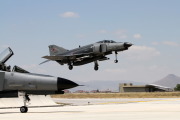 |
|
Still going
strong with the Turkish Air Force
|
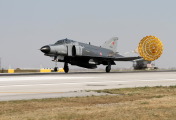 |
|
These upgraded
F-4 Phantoms are referred to as the F-4E-2020 Terminator.
|
At the end of 20th century it became
clear that air forces would continue to play a major role in deterrence
and in the determination of the outcome of future wars. Experiences
gained in allied operations in Iraq, the Balkan conflict of the
nineties, Afghanistan and more recently Libya has reconfirmed the
necessity of controlling the air in order to eventually win the war on
the ground.
Turkey plays a pivotal role in the region, based upon their geography,
placing them between the East and the West. The Turkish Air Force, as
one of the major air forces in the region has gained in numbers and
strength from the beginning of the 1980s when Turkey as a rising power
and important NATO member started to invest in infrastructure,
modernization of weapons systems and training.
Birth of a new air exercise in Turkey
The new exercise, called “Anatolian Eagle” was initiated in 2001, to
simulate air warfare scenarios in the context of national and
multinational training. The Anatolian Eagle (AE) Training Centre was
built at 3rd Main Jet Base at Konya, located in Central Anatolia in
Turkey. It sits on the periphery of the vast Konya plain, a sparsely
populated flat basin, an ideal location for a complex air exercise.
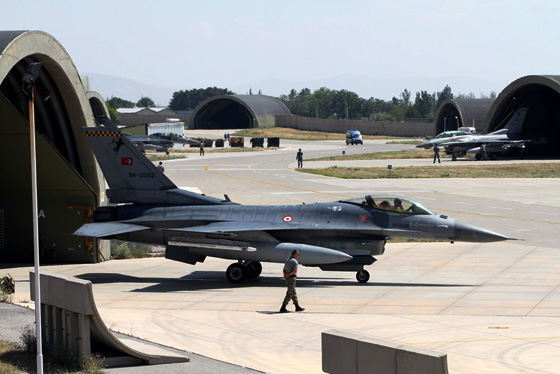
Turkish forces preparing from the
shelter aria .
The extensive dedicated training area
for AE was established between 1998 and 2001 and the air training area
measures 100 miles in length and 95 miles in width. Turkey has held
three to four AE exercises every year from 2001 to today, with a mix of
participants from both from the West (eight NATO partners have already
participated) and the East, including Jordan, Pakistan, Saudi Arabia,
U.A.E. and – perhaps more surprisingly – Israel . Almost forty AE
exercises took place since 2001, with thirteen countries participating,
besides the host nation. Worth noting is that in 2010 China took part in
an air exercise in Turkey, most likely AE 2010/3, but given the complex
relation between China and the West and Turkey being a NATO partner, no
official confirmation was given related to PLAAF aircraft being in
Turkey or participating in the AE exercise.
By now, AE has grown into one of the
largest and most complex joint air force exercises in the world,
paralleled only by Red Flag, held periodically at Nevada’s Nellis Air
Force Base, and the annual Maple Flag exercise in Canada. Within ten
years, the Turkish Air Force has grown into a level where it is able to
perform on par with most and train air forces of other countries.
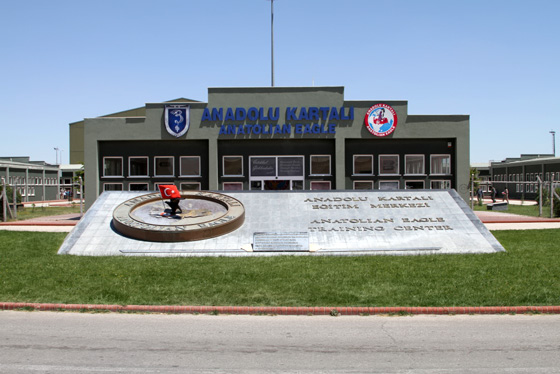
Anatolian Eagle Main building with the main briefing room.
In the background are the rooms fore the different forces.
|
Participating forces
|
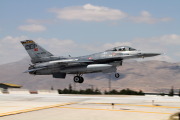 |
|
The Turkish air
force participated with several F-16 units as well as
F-4'and some slow movers. |
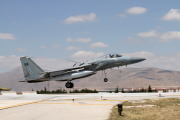 |
|
Saudi Arabia send
a detachment of F-15C and D from 13 Sqn.
|
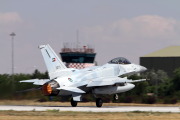 |
|
And the United
Arab Emirates participated with F-16E's from the Shaheen Sqn |
We visited the second AE of 2013, a
multinational exercise with participants from Turkey, U.A.E., Saudi
Arabia and NATO, bringing a total of almost sixty jet aircraft to Konya.
The build-up to this exercise on unit level starts six to twelve months
in advance, while the exercise itself lasts two weeks.
Running the exercise today
AE provides an accurate simulated war environment, with its training
grounds equipped with the latest technology, including an electronic
warfare area, enabling real-time data concerning aircraft movement to be
relayed to ground control through air combat manoeuvring instrumentation
pods.
The ground units in the dedicated AE village on the base, consist of a
command and control centre, a main briefing auditorium and separate
buildings for the participant groups known respectively as the WHITE,
BLUE and RED forces. The WHITE forces, composed of TUAF personnel and
allied observers, are in charge of planning; they develop training and
intelligence scenarios, establish levels of training, plan air tasking
orders, monitor real-time executed training, and direct training from
the ground.
The BLUE forces are composed of allied air forces as well as Turkish
Army and Naval units. The RED forces are composed of TUAF F-16 units,
rotating in from across the country, along with surface-to-air missile
units dispersed on the scorching hot Anatolian plains..
The base scenario consists of an attack by the BLUE team through a
Combined Air Operation (COMAO) on the tactical and strategic targets in
RED-lands which are being defended by RED force fighter aircraft and SAM
systems. During the exercise, AWACS aircraft gave command and control
support to BLUE forces while land-based radar systems supported the RED
forces. From the base scenario, more complexity is added throughout the
two training weeks, such as tighter operating envelopes, higher threat
levels and reduced preparation time.
The heart of the operation is monitored in the Command Control Centre (CCC).
Pride of the extensive facilities at Konya is the MASE (Multi Aegis Site
Emulator) Operation Centre, where all AE sorties and all other military
flights are controlled and commanded from. Also, the tracks detected by
AWACS and land radars and real-time searching, locking and shooting
images of SAM and anti-aircraft systems can be observed here. The main
briefing hall, which is located in the same building as the CCC, has a
capacity of 450 people enabling joint briefings and debriefings.
We visited Konya in the beginning of June, the period when the
temperature on the ramp is already above thirty degree Celsius when the
first mission starts. The press events on AE tend to be towards the end
of the training period, so we were able to witness the integrated
mission package at its fullest. The high level of the exercise combined
with the hospitality of the Turkish Air Force and its staff has made AE
into the regions’ most loved exercise as is proven by returning
participants.
This was also mirrored in the reception of the Turkish Air Force towards
the visiting journalists, for which we thank them. We will certainly try
and return to Konya when the opportunity arises.
We thank the Turkish Air Force HQ for arranging our visit to
Anatolian Eagle 2013/2 and especially the staff of at 3rd main jet base
Konya for their hospitality. |